2016 Peugeot Expert VU service
[x] Cancel search: servicePage 162 of 520
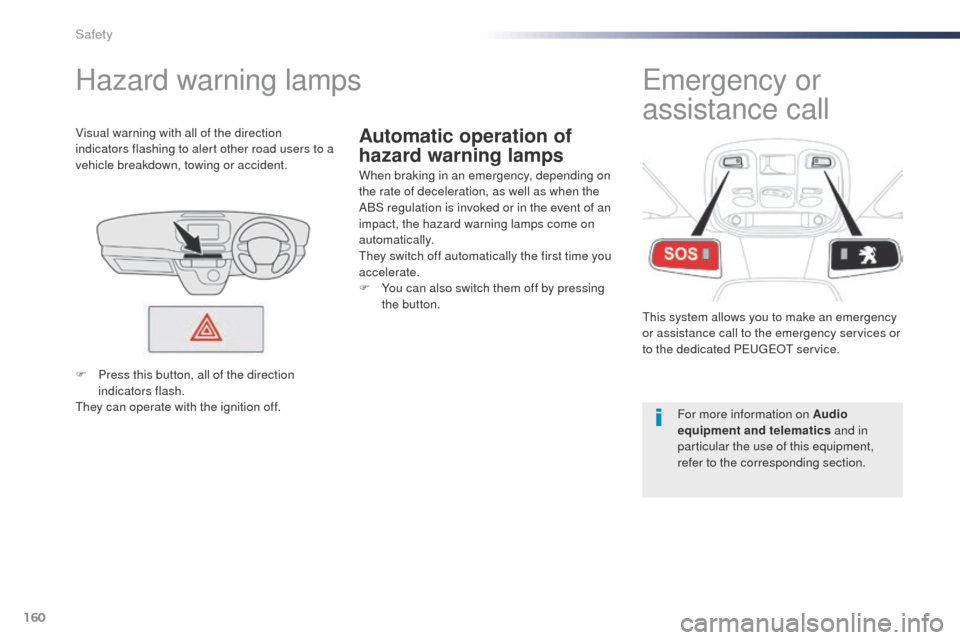
160
Automatic operation of
hazard warning lamps
Hazard warning lamps
When braking in an emergency, depending on
the rate of deceleration, as well as when the
ABS regulation is invoked or in the event of an
impact, the hazard warning lamps come on
automatically.
th
ey switch off automatically the first time you
accelerate.
F
Y
ou can also switch them off by pressing
the button.
Visual warning with all of the direction
indicators flashing to alert other road users to a
vehicle breakdown, towing or accident.
emergency or
assistance call
this system allows you to make an emergency
or assistance call to the emergency services or
to the dedicated P
e
ugeot service.
For more information on Audio
equipment and telematics and in
particular the use of this equipment,
refer to the corresponding section.
F
P
ress this button, all of the direction
indicators flash.
th
ey can operate with the ignition off.
Safety
Page 246 of 520
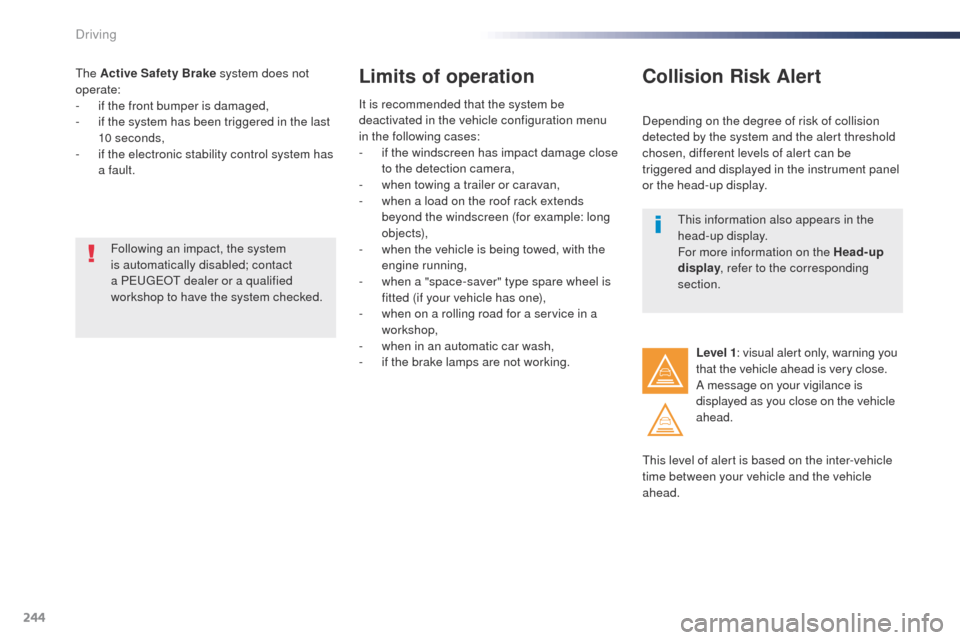
244
the Active Safety Brake system does not
operate:
-
i
f the front bumper is damaged,
-
i
f the system has been triggered in the last
10 seconds,
-
i
f the electronic stability control system has
a fault.Limits of operation
It is recommended that the system be
deactivated in the vehicle configuration menu
in the following cases:
-
i
f the windscreen has impact damage close
to the detection camera,
-
w
hen towing a trailer or caravan,
-
w
hen a load on the roof rack extends
beyond the windscreen (for example: long
objects),
-
w
hen the vehicle is being towed, with the
engine running,
-
w
hen a "space-saver" type spare wheel is
fitted (if your vehicle has one),
-
w
hen on a rolling road for a service in a
workshop,
-
w
hen in an automatic car wash,
-
i
f the brake lamps are not working.
Following an impact, the system
is automatically disabled; contact
a P
e
ugeot
dealer or a qualified
workshop to have the system checked.
Collision Risk Alert
Depending on the degree of risk of collision
detected by the system and the alert threshold
chosen, different levels of alert can be
triggered and displayed in the instrument panel
or the head-up display.
th
is level of alert is based on the inter-vehicle
time between your vehicle and the vehicle
ahead. Level 1
: visual alert only, warning you
that the vehicle ahead is very close.
A message on your vigilance is
displayed as you close on the vehicle
ahead.
th
is information also appears in the
head-up display.
For more information on the Head-up
display , refer to the corresponding
section.
Driving
Page 247 of 520
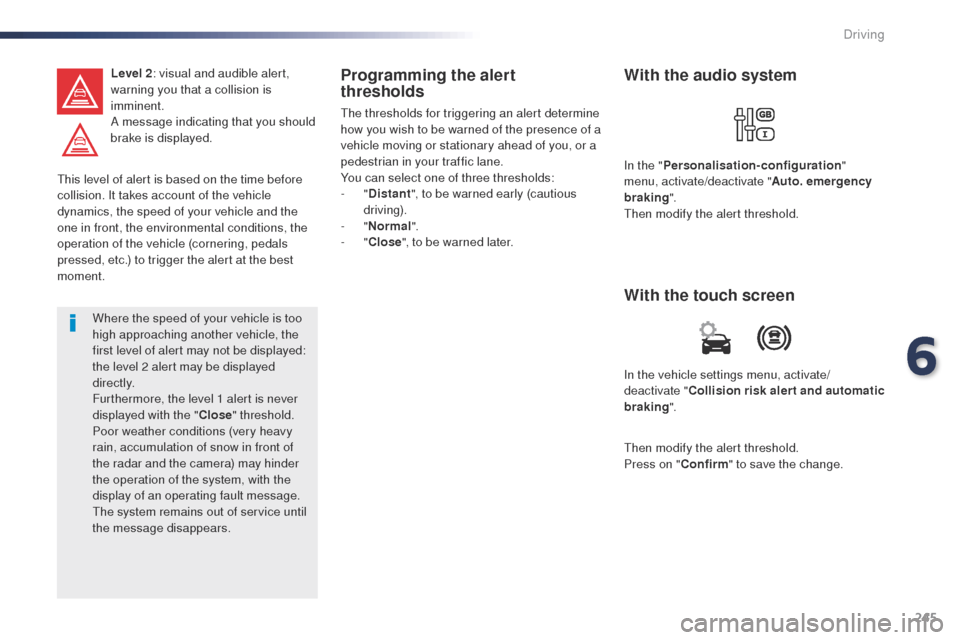
245
this level of alert is based on the time before
collision. It takes account of the vehicle
dynamics, the speed of your vehicle and the
one in front, the environmental conditions, the
operation of the vehicle (cornering, pedals
pressed, etc.) to trigger the alert at the best
moment.Level 2
: visual and audible alert,
warning you that a collision is
imminent.
A message indicating that you should
brake is displayed.
Where the speed of your vehicle is too
high approaching another vehicle, the
first level of alert may not be displayed:
the level 2 alert may be displayed
di r e c t l y.
Furthermore, the level 1 alert is never
displayed with the " Close" threshold.
Poor weather conditions (very heavy
rain, accumulation of snow in front of
the radar and the camera) may hinder
the operation of the system, with the
display of an operating fault message.
th
e system remains out of service until
the message disappears.
Programming the alert
thresholds
the thresholds for triggering an alert determine
how you wish to be warned of the presence of a
vehicle moving or stationary ahead of you, or a
pedestrian in your traffic lane.
You can select one of three thresholds:
-
"Distant ", to be warned early (cautious
driving).
-
"Normal ".
-
"Close ", to be warned later.
In the vehicle settings menu, activate/
deactivate "Collision risk alert and automatic
braking ".
With the touch screen With the audio system
In the "Personalisation-configuration "
menu, activate/deactivate " Auto. emergency
braking ".
th
en modify the alert threshold.
th
en modify the alert threshold.
Press on " Confirm" to save the change.
6
Driving
Page 266 of 520
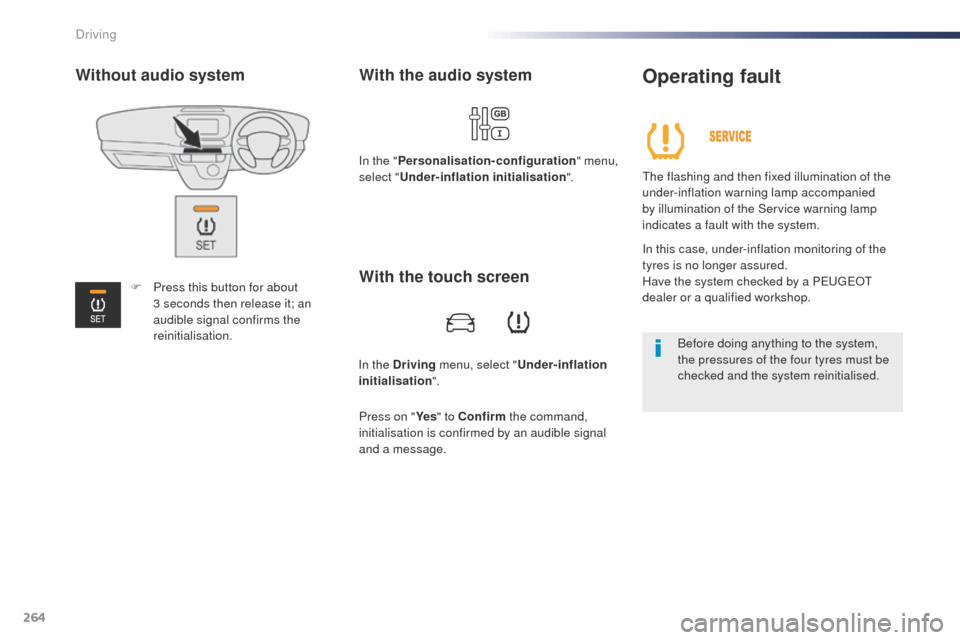
264
In the Driving menu, select " Under-inflation
initialisation ".
With the audio system
In the "Personalisation-configuration " menu,
select " Under-inflation initialisation ".
Operating fault
the flashing and then fixed illumination of the
under-inflation warning lamp accompanied
by illumination of the Service warning lamp
indicates a fault with the system.
In this case, under-inflation monitoring of the
tyres is no longer assured.
Have the system checked by a P
e
ugeot
dealer or a qualified workshop.
Before doing anything to the system,
the pressures of the four tyres must be
checked and the system reinitialised.
With the touch screen
Press on " Ye s" to Confirm the command,
initialisation is confirmed by an audible signal
and a message.
Without audio system
F Press this button for about 3 seconds then release it; an
audible signal confirms the
reinitialisation.
Driving
Page 274 of 520
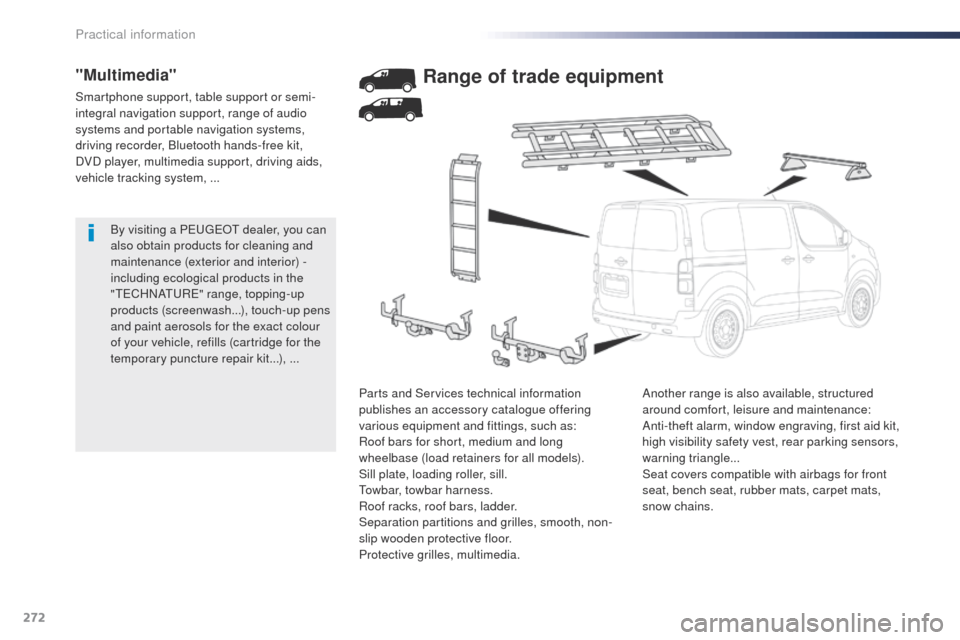
272
By visiting a Peugeot dealer, you can
also obtain products for cleaning and
maintenance (exterior and interior)
-
including ecological products in the
"
t
e
C
HNA
t
u
Re" r
ange, topping-up
products (screenwash...), touch-up pens
and paint aerosols for the exact colour
of your vehicle, refills (cartridge for the
temporary puncture repair kit...), ...
"Multimedia"
Smartphone support, table support or semi-
integral navigation support, range of audio
systems and portable navigation systems,
driving recorder, Bluetooth hands-free kit,
DVD
player, multimedia support, driving aids,
vehicle tracking system,
...
Range of trade equipment
Another range is also available, structured
around comfort, leisure and maintenance:
Anti-theft alarm, window engraving, first aid kit,
high visibility safety vest, rear parking sensors,
warning triangle...
Seat covers compatible with airbags for front
seat, bench seat, rubber mats, carpet mats,
snow chains.
Parts and Services technical information
publishes an accessory catalogue offering
various equipment and fittings, such as:
Roof bars for short, medium and long
wheelbase (load retainers for all models).
Sill plate, loading roller, sill.
to
wbar, towbar harness.
Roof racks, roof bars, ladder.
Separation partitions and grilles, smooth, non-
slip wooden protective floor.
Protective grilles, multimedia.
Practical information
Page 280 of 520

278
Checking levels
take care when working under the bonnet, as certain areas of the engine may be extremely hot (risk of burns) and the cooling fan could start at
any time (even with the ignition off).
Engine oil level
the check is carried out either when
the ignition is switched on using the
oil level indicator in the instrument
panel for vehicles so equipped, or
using the dipstick.Checking using the dipstick
the location of the dipstick is shown in the
corresponding underbonnet layout view.
F t
a
ke the dipstick by its coloured grip and
remove it completely.
F
W
ipe the end of the dipstick using a clean
non-fluffy cloth.
F
R
efit the dipstick and push fully down, then
pull it out again to make the visual check:
the correct level is between the marks A
and B .
Check all of these levels regularly, in line with the manufacturer's service schedule.
t
o
p them up if necessary, unless other wise indicated.
If a level drops significantly, have the corresponding system checked by a P
e
ugeot dealer or a qualified workshop.
A = MA X
to e
nsure that the reading is correct, your
vehicle must be parked on a level sur face
with the engine having been off for more than
30
minutes.
It is normal to top-up the oil level between
two services (or oil changes). P
e
ugeot
recommends that you check the level, and top-
up if necessary, every 3 000 miles (5 000 kms). B = MIN
If you find that the level is above the A mark or
below the B mark, do not star t the engine .
-
I
f the level is above the MAX mark (risk
of damage to the engine), contact a
P
e
ugeot dealer or a qualified workshop.
-
I
f the level is below the MIN mark, you
must top-up the engine oil.
Practical information
Page 281 of 520
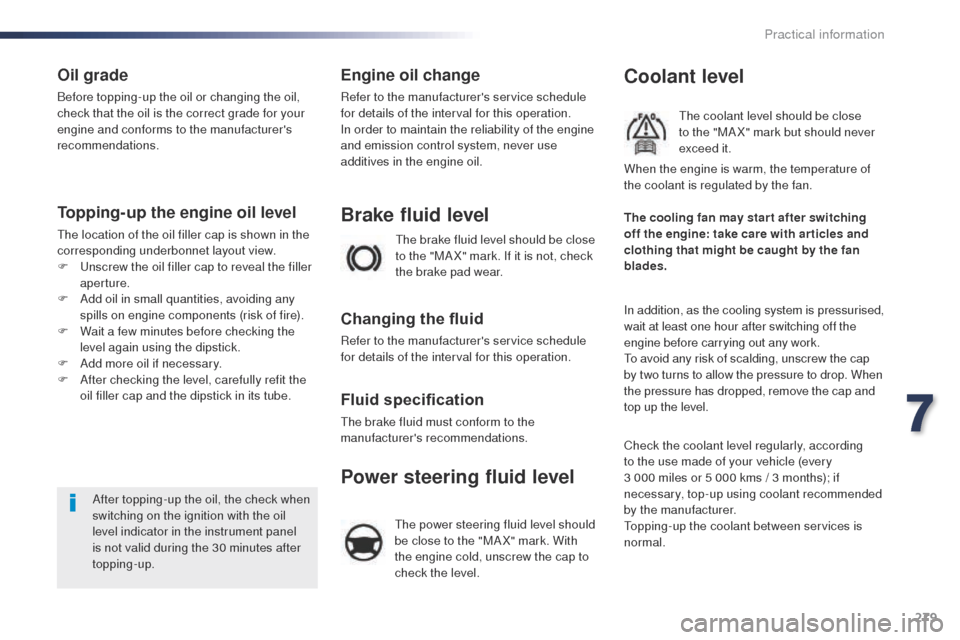
279
Oil grade
Before topping-up the oil or changing the oil,
check that the oil is the correct grade for your
engine and conforms to the manufacturer's
recommendations.
Topping-up the engine oil level
the location of the oil filler cap is shown in the
corresponding underbonnet layout view.
F u
n
screw the oil filler cap to reveal the filler
aperture.
F
A
dd oil in small quantities, avoiding any
spills on engine components (risk of fire).
F
W
ait a few minutes before checking the
level again using the dipstick.
F
A
dd more oil if necessary.
F
A
fter checking the level, carefully refit the
oil filler cap and the dipstick in its tube.
After topping-up the oil, the check when
switching on the ignition with the oil
level indicator in the instrument panel
is not valid during the 30 minutes after
topping-up.
Engine oil change
Refer to the manufacturer's service schedule
for details of the interval for this operation.
In order to maintain the reliability of the engine
and emission control system, never use
additives in the engine oil.
th
e brake fluid level should be close
to the "MA X" mark. If it is not, check
the brake pad wear.
Brake fluid level
Changing the fluid
Refer to the manufacturer's service schedule
for details of the interval for this operation.
Fluid specification
the brake fluid must conform to the
manufacturer's recommendations.
Coolant level
the coolant level should be close
to the "MA X" mark but should never
exceed it.
In addition, as the cooling system is pressurised,
wait at least one hour after switching off the
engine before carrying out any work.
to a
void any risk of scalding, unscrew the cap
by two turns to allow the pressure to drop. When
the pressure has dropped, remove the cap and
top up the level. The cooling fan may star t after switching
off the engine: take care with ar ticles and
clothing that might be caught by the fan
blades. When the engine is warm, the temperature of
the coolant is regulated by the fan.
Check the coolant level regularly, according
to the use made of your vehicle (every
3 000
miles or 5 000 kms / 3 months); if
necessary, top-up using coolant recommended
by the manufacturer.
to
pping-up the coolant between services is
normal.
Power steering fluid level
the power steering fluid level should
be close to the "MA X" mark. With
the engine cold, unscrew the cap to
check the level.
7
Practical information
Page 282 of 520
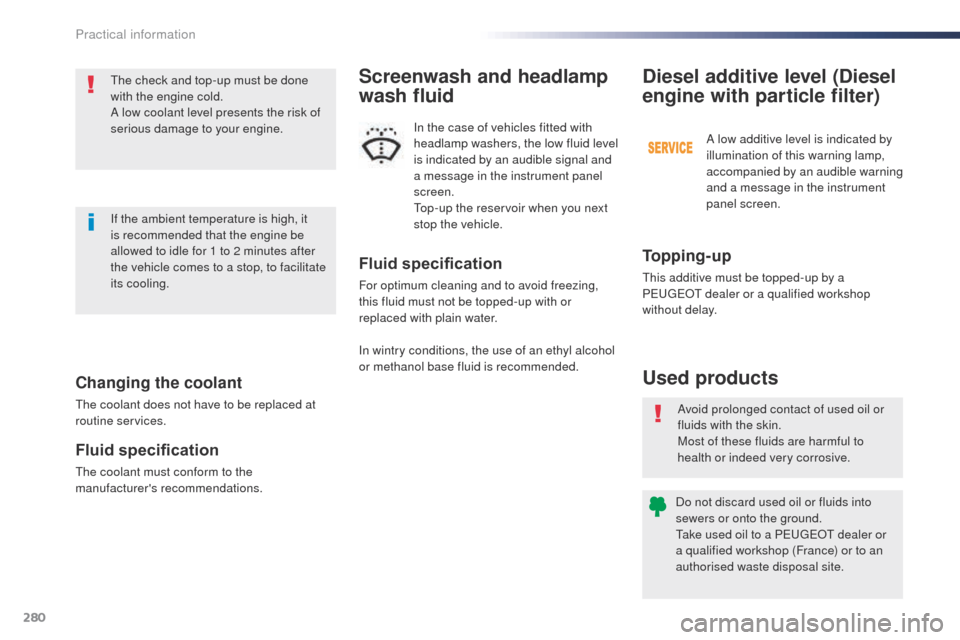
280
Changing the coolant
the coolant does not have to be replaced at
routine services.
Fluid specification
the coolant must conform to the
manufacturer's recommendations.
th
e check and top-up must be done
with the engine cold.
A low coolant level presents the risk of
serious damage to your engine.
If the ambient temperature is high, it
is recommended that the engine be
allowed to idle for 1 to 2 minutes after
the vehicle comes to a stop, to facilitate
its cooling.
Avoid prolonged contact of used oil or
fluids with the skin.
Most of these fluids are harmful to
health or indeed very corrosive.
Do not discard used oil or fluids into
sewers or onto the ground.
ta
ke used oil to a P
e
ugeot dealer or
a qualified workshop (France) or to an
authorised waste disposal site.
Used products
To p p i n g - u p
this additive must be topped-up by a
Pe ugeot dealer or a qualified workshop
without delay.
Diesel additive level (Diesel
engine with particle filter)
A low additive level is indicated by
illumination of this warning lamp,
accompanied by an audible warning
and a message in the instrument
panel screen.
Fluid specification
For optimum cleaning and to avoid freezing,
this fluid must not be topped-up with or
replaced with plain water.
Screenwash and headlamp
wash fluid
In the case of vehicles fitted with
headlamp washers, the low fluid level
is indicated by an audible signal and
a message in the instrument panel
screen.
to
p-up the reservoir when you next
stop the vehicle.
In wintry conditions, the use of an ethyl alcohol
or methanol base fluid is recommended.
Practical information